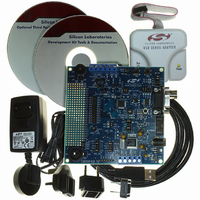C8051F410DK Silicon Laboratories Inc, C8051F410DK Datasheet - Page 56

C8051F410DK
Manufacturer Part Number
C8051F410DK
Description
KIT DEV FOR C8051F41X
Manufacturer
Silicon Laboratories Inc
Type
MCUr
Specifications of C8051F410DK
Contents
Evaluation Board, Power Supply, USB Cables, Adapter and Documentation
Processor To Be Evaluated
C8051F41x
Interface Type
USB
Silicon Manufacturer
Silicon Labs
Core Architecture
8051
Silicon Core Number
C8051F410
Silicon Family Name
C8051F41x
Lead Free Status / RoHS Status
Contains lead / RoHS non-compliant
For Use With/related Products
Silicon Laboratories C8051F41x
Lead Free Status / Rohs Status
Lead free / RoHS Compliant
Other names
336-1314
Available stocks
Company
Part Number
Manufacturer
Quantity
Price
Company:
Part Number:
C8051F410DK
Manufacturer:
Silicon Labs
Quantity:
135
- Current page: 56 of 270
- Download datasheet (2Mb)
C8051F410/1/2/3
5.3.4. Burst Mode
Burst Mode is a power saving feature that allows ADC0 to remain in a low power state between conver-
sions. When Burst Mode is enabled, ADC0 wakes from a low power state, accumulates 1, 4, 8, or 16 sam-
ples using an internal Burst Mode clock (approximately 25 MHz), then re-enters a low power state. Since
the Burst Mode clock is independent of the system clock, ADC0 can perform multiple conversions then
enter a low power state within a single system clock cycle, even if the system clock is slow (e.g.
32.768 kHz), or suspended.
Burst Mode is enabled by setting BURSTEN to logic 1. When in Burst Mode, AD0EN controls the ADC0
idle power state (i.e. the state ADC0 enters when not tracking or performing conversions). If AD0EN is set
to logic 0, ADC0 is powered down after each burst. If AD0EN is set to logic 1, ADC0 remains enabled after
each burst. On each convert start signal, ADC0 is awakened from its Idle Power State. If ADC0 is powered
down, it will automatically power up and wait the programmable Power-Up Time controlled by the
AD0PWR bits. Otherwise, ADC0 will start tracking and converting immediately. Figure 5.5 shows an exam-
ple of Burst Mode Operation with a slow system clock and a repeat count of 4.
Important Note: When Burst Mode is enabled, only Post-Tracking and Dual-Tracking modes can be used.
When Burst Mode is enabled, a single convert start will initiate a number of conversions equal to the repeat
count. When Burst Mode is disabled, a convert start is required to initiate each conversion. In both modes,
the ADC0 End of Conversion Interrupt Flag (AD0INT) will be set after “repeat count” conversions have
been accumulated. Similarly, the Window Comparator will not compare the result to the greater-than and
less-than registers until “repeat count” conversions have been accumulated.
Note: When using Burst Mode, care must be taken to issue a convert start signal no faster than once every
four SYSCLK periods. This includes external convert start signals.
56
D u a l-T ra ckin g
D u a l-T ra ckin g
P o st-T ra ckin g
P o st-T ra ckin g
S yste m C lo ck
C o n ve rt S ta rt
A D 0 T M = 0 1
A D 0 T M = 1 1
A D 0 T M = 0 1
A D 0 T M = 1 1
A D 0 E N = 0
A D 0 E N = 0
A D 0 E N = 1
A D 0 E N = 1
Figure 5.5. 12-Bit ADC Burst Mode Example with Repeat Count Set to 4
T = T ra ckin g
C = C o n ve rtin g
P o w e re d
P o w e re d
D o w n
D o w n
T ra ck
Id le
T C
T C
P o w e r-U p
P o w e r-U p
a n d T ra ck
A D 0 P W R
a n d Id le
T C
T C
T C
T C
T C
T C
T C
T C
T C
T C
Rev. 1.1
T C
T C
T C
T C
T ra ck
Id le
P o w e re d
P o w e re d
D o w n
D o w n
T C
T C
P o w e r-U p
P o w e r-U p
a n d T ra ck
a n d Id le
T C
T C
T C ..
T C ..
T C ..
T C ..
Related parts for C8051F410DK
Image
Part Number
Description
Manufacturer
Datasheet
Request
R
Part Number:
Description:
SMD/C°/SINGLE-ENDED OUTPUT SILICON OSCILLATOR
Manufacturer:
Silicon Laboratories Inc
Part Number:
Description:
Manufacturer:
Silicon Laboratories Inc
Datasheet:
Part Number:
Description:
N/A N/A/SI4010 AES KEYFOB DEMO WITH LCD RX
Manufacturer:
Silicon Laboratories Inc
Datasheet:
Part Number:
Description:
N/A N/A/SI4010 SIMPLIFIED KEY FOB DEMO WITH LED RX
Manufacturer:
Silicon Laboratories Inc
Datasheet:
Part Number:
Description:
N/A/-40 TO 85 OC/EZLINK MODULE; F930/4432 HIGH BAND (REV E/B1)
Manufacturer:
Silicon Laboratories Inc
Part Number:
Description:
EZLink Module; F930/4432 Low Band (rev e/B1)
Manufacturer:
Silicon Laboratories Inc
Part Number:
Description:
I°/4460 10 DBM RADIO TEST CARD 434 MHZ
Manufacturer:
Silicon Laboratories Inc
Part Number:
Description:
I°/4461 14 DBM RADIO TEST CARD 868 MHZ
Manufacturer:
Silicon Laboratories Inc
Part Number:
Description:
I°/4463 20 DBM RFSWITCH RADIO TEST CARD 460 MHZ
Manufacturer:
Silicon Laboratories Inc
Part Number:
Description:
I°/4463 20 DBM RADIO TEST CARD 868 MHZ
Manufacturer:
Silicon Laboratories Inc
Part Number:
Description:
I°/4463 27 DBM RADIO TEST CARD 868 MHZ
Manufacturer:
Silicon Laboratories Inc
Part Number:
Description:
I°/4463 SKYWORKS 30 DBM RADIO TEST CARD 915 MHZ
Manufacturer:
Silicon Laboratories Inc
Part Number:
Description:
N/A N/A/-40 TO 85 OC/4463 RFMD 30 DBM RADIO TEST CARD 915 MHZ
Manufacturer:
Silicon Laboratories Inc
Part Number:
Description:
I°/4463 20 DBM RADIO TEST CARD 169 MHZ
Manufacturer:
Silicon Laboratories Inc











